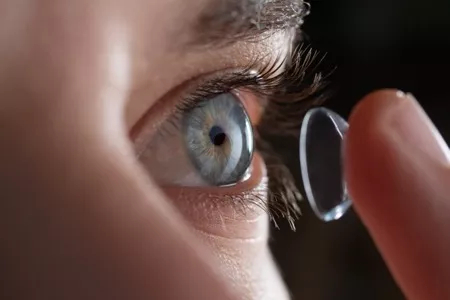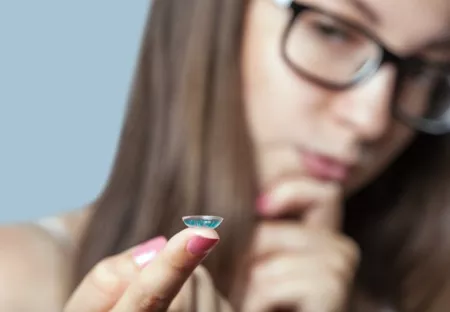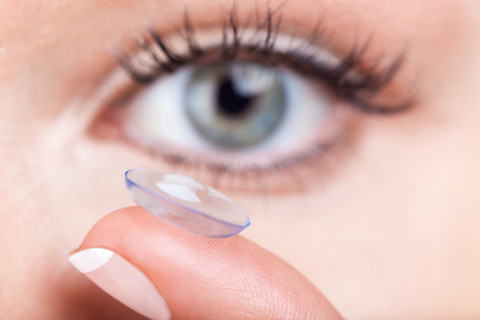The ability to see things clearly, whether it’s leaves on a tree, road signs, the lines of text in a book, or the face of your loved one, is something people can take for granted unless they face vision challenges. Wearing
contact lenses can be a game-changer for people who want to enjoy improved eyesight without glasses or corrective vision surgery. If you’re considering contacts, check out our beginner’s guide to wearing contacts!
- Types of contact lenses
- Finding the right contacts for you
- Understanding your contact lens prescription
- Inserting your contact lenses
- Removing your contact lenses
- Frequently asked questions for wearing contacts
Types of Contact Lenses
Before you get a prescription for contacts, there are a few things you should know. First, there are two general categories of contact lenses: soft contact lenses and rigid gas permeable (RGP) contact lenses.
The first few years of experimentation with contact lenses weren’t nearly as comfortable of an experience as it is today. Contact lenses of the past were made of glass and other hard materials that were heavy and often uncomfortable to wear. As technology has advanced, so have the designs of our contact lenses. Although more people opt for soft lenses, RGPs have great advantages that many people still prefer.
These lenses are resistant to the build-up of deposits and more durable than soft lenses, meaning they’re less likely to tear and therefore easier to handle. RGP lenses also tend to provide clearer vision. However, the adjustment period for RGPs tends to be longer, with customers saying it can take a few weeks to adjust to the lenses' feeling rather than a few days when adjusting to soft contacts.
Soft contact lenses are far more popular than RGP and are made with flexible, soft plastic that allows oxygen to reach the cornea. If you struggle with dry eyes, soft contact lenses are a great choice, especially those that feature silicone hydrogels, a material that allows more oxygen to reach your eye during use.
How Long Can You Wear Contact Lenses?
Beyond the initial two categories, soft contact lenses come in various styles, including extended wear, disposable replacement schedule lenses, and decorative lenses. The contact lens style prescribed to you determines how long you can wear each lens before disposing of it.
Although many people say their contact lenses are disposable, the
United States Food and Drug Administration (FDA) defines disposable as a contact lens that is discarded after only one use. Disposable lenses, known correctly as frequent or planned replacement schedule lenses, can be worn continuously for a prescribed amount of time and then discarded. These times range from one to thirty days and are determined by the manufacturer.
Extended wear contact lenses are manufactured to be worn the longest amount of time continuously of any replacement schedule contact lenses. According to the FDA, patients can wear extended wear lenses continuously for between one and six nights or up to thirty days. These lenses are usually soft contacts, but there are a handful of RGP lenses that fall under this category, as well. The amount of time you can constantly wear a single pair of contacts depends on the lens type and your eye doctor’s recommendations. If you are approved for extended wear lenses, it’s essential to leave your contacts out for at least one full night in between each scheduled lens change to allow your eye time to breathe.
Disposable replacement schedule contact lenses are intended to be discarded after a short amount of time, typically between one and thirty days. These contacts include
daily lenses, weekly or bi-weekly lenses, and monthly lenses. Wearing contacts can have a drastic impact on your vision, but it’s crucial to clean and disinfect your contacts upon removal and before insertion to keep your eyes happy and healthy.
Understanding Your Contact Lens Prescription
As your vision changes, you’ll learn to understand the different numbers present on the prescription you receive after your
eye exam. These numbers indicate the power, base curve, and diameter of your vision correction needs and may also include other numbers if you have astigmatism or presbyopia. Here’s a breakdown of the main values:
Power: A positive or negative number indicating the amount of correction to your myopia or hyperopia. If you are farsighted, also known as hyperopia, you’ll need contacts with a positive power. If you are nearsighted, also known as myopia, you’ll need contacts with a negative power.
Base curve: This number is typically established by the manufacturer and indicates the eye's amount of natural curve. There are usually two options for a base curve. Choosing the correct curvature ensures your contacts fit correctly on your eyes, giving you the best vision possible.
Diameter: The width of your contact lenses is another key element to ensuring a snug fit.
If you have astigmatism, your doctor will prescribe
toric lenses. Astigmatism causes blurry vision because of a refractive error in the eye. Manufacturers design these lenses to fit the astigmatic eye or eyes to provide clear and balanced vision. Toric prescriptions include two additional values:
Cylinder: This is the amount of vision correction needed to accommodate astigmatism and is measured in increments of 0.25.
Axis: This is the angle of correction needed to provide clear vision. The number will range from zero to 180.
Presbyopia is a common eye condition that typically impacts adults over age forty. The condition is caused by a loss of elasticity in the eye's lens and impacts your ability to see items up close. If your eye doctor has diagnosed you with presbyopia, you’ll see two additional indications on your prescription that create multifocal lenses:
Addition: This is the amount of correction needed to provide clear vision for near sight.
Dominant eye: A “D” on your prescription indicates which eye is your dominant eye.
Inserting Your Contact Lenses
 Wearing contacts may seem complicated at first, but once you get the hang of inserting and removing them, it will become second nature. Before sending you home, your eye doctor will help explain how your eyes will need time to adjust to wearing contacts. The same is true for the adjustment period it will take to become comfortable inserting and removing your lenses.
Wearing contacts may seem complicated at first, but once you get the hang of inserting and removing them, it will become second nature. Before sending you home, your eye doctor will help explain how your eyes will need time to adjust to wearing contacts. The same is true for the adjustment period it will take to become comfortable inserting and removing your lenses.
Your eye doctor will help you establish a routine for wearing contacts that typically includes increasing the amount of time you spend using them, starting with an hour or two, and gradually working up to all day. Here are step-by-step instructions on how to insert your contact lenses.
Step one: Before touching your contacts, thoroughly wash and dry your hands to remove any oils or other substances that could be transferred to your eye.
Step two: Scoop the lens out of the case and place it on the tip of your pointer finger. Examine the lens to make sure that the outer edges look like a bowl. If the edges appear to be curving outwards, your lens is inside out.
Step three: Using two fingers from your opposite hand, gently hold your upper eyelid up and your lower eyelid down. Some people use their middle finger from each hand to hold their eye open, but ultimately, it’s up to you to find the method that works best.
Step four: Gently place the contact lens on your eye and blink a few times to position it correctly. Sometimes it helps to look to the side while inserting your contact lens rather than directly at the lens. This motion will take practice but will eventually become something you don’t even have to think about.
Removing Your Contact Lenses
Like the process for inserting your contacts, removing them will take some getting used to, but it definitely gets easier as time goes on. Here are step-by-step instructions for removing contact lenses.
Step one: Thoroughly wash your hands with soap and warm water before handling your contacts or contact lens case. Once your hands are clean, open your contact lens case and fill it with the clean disinfecting solution recommended by your eye care professional.
Step two: With the same motion you used to insert your lenses, gently pull your upper eyelid up and your lower eyelid down.
Step three: Use your index finger to gently slide the lens down toward your lower eyelid. Once you have moved the lens a small amount, proceed to the next step without removing your index finger.
Step four: Carefully pinch the lens between your thumb and index finger and remove it from your eye. It may be helpful to look away instead of directly at your fingers as you remove the lens.
Once you’ve removed the lens, place it into the case with a clean disinfectant solution and close the lid. Rewash your hands and place your contacts case in a safe location.
How to Clean Your Contact Lenses
Keeping your contact lenses clean is vital to the health of your eyes. Your doctor will likely provide you with a contact lens case and a small bottle of cleaning solution. Although you can select a different solution, it’s important to understand if your lens brand works best with a certain type of solution or if your doctor has a recommendation based on our eye care needs.
There are two primary types of contact lens disinfectant solutions: multipurpose solution and hydrogen peroxide-based solutions. Multipurpose solution is an all-in-one system used to store, clean, disinfect, and rinse your contact lenses. If you have soft contacts, you’re most likely using this type of solution.
Hydrogen peroxide-based solution is a more involved process for storage and disinfecting, but it works well for people with sensitivities to chemicals or environmental allergies. This type of solution works well for people whose eyes create larger amounts of protein deposits and is also known to help prevent acanthamoeba keratitis, a dangerous eye infection that can cause blindness.
You can use a multipurpose solution with any basic contact lens case. However, using a hydrogen peroxide solution requires a specialized case containing a platinum-coated disk that neutralizes the hydrogen peroxide, turning it into a saline solution that is safe for the eyes. Speak with your eye doctor about wearing contacts and the right type of solution for your needs.
Although it may seem smart to store or clean your contact lenses with water, impurities exist in tap water that can cause life-threatening infections. It’s always better to throw away a pair of lenses than use a solution that isn’t intended for use on your lenses. You should also avoid swimming in your contacts or using eye drops that aren’t specifically intended for use with contact lenses.
Frequently Asked Questions for Wearing Contacts
 When you first receive your prescription for wearing contacts, you may have a lot of questions. How long can I wear contacts? Can I lose a contact lens in my eye? Can I sleep in my contact lenses? Where should I buy my contacts? Your eye doctor should be able to answer any questions you have about wearing contacts, but in case you need a refresher, here are the questions and answers we most commonly hear:
When you first receive your prescription for wearing contacts, you may have a lot of questions. How long can I wear contacts? Can I lose a contact lens in my eye? Can I sleep in my contact lenses? Where should I buy my contacts? Your eye doctor should be able to answer any questions you have about wearing contacts, but in case you need a refresher, here are the questions and answers we most commonly hear:
How Long Can I Wear Contacts?
Each type of contact lens has a different material make-up, wear recommendations, and replacement schedule. It’s essential to talk to your eye care professional about your preferences and lifestyle so they can help determine the best lenses for you. Unless you are prescribed extended wear contacts, you should always remove your lenses before falling asleep, even for a short nap. Wearing contacts longer than they are intended can cause an infection and even blindness if left untreated.
The same principle goes for replacing your contacts. If you are prescribed contact lenses that you are supposed to wear each day for two weeks, you can cause an infection by overwearing them. Protein can also build-up on the surface of lenses that have been worn for too long and cause blurry vision. Always follow recommendations by the manufacturer and your eye doctor for wearing and replacing your lenses.
Can I Lose a Contact Lens in My Eye?
Concerns about the possibility of losing a contact lens in the eye are one of the most frequent questions we hear from new users. Luckily, the answer is no; you cannot lose a contact lens behind your eyeball. There are occasions where patients will have trouble locating their lens, but that occurs when they have rubbed their eye and dislodged the lens, typically causing it to move under the upper eyelid. If you feel as though you have lost your contact lens, but you don’t feel anything in your eye, look around on the counter or floor. Sometimes lenses can become dislodged during insertion or removal and fall off the tip of your finger, giving the impression that the lens is lost. If you can’t remove the lens from your eye, your eye care provider can help you find and remove the lens.
Can I Sleep in My Contact Lenses?
This question is similar to how long you can wear your contacts. Unless you have a prescription for extended wear contacts, you should never sleep in your lenses. Sleeping in your contact lenses can cause infections, irritations, and dry eyes.
What Types of Contacts Are There?
In addition to lenses that correct your vision, manufacturers have also created several specialty options without vision-correcting options.
Colored contacts: If you want to change your eyes' appearance, wearing contacts with a colored overlay can make a bold statement without much effort. These lenses do require a prescription to ensure a correct fit, but your eye doctor can easily help you find the right style and color for you.
Theatrical contacts: You’ve probably seen movies, television shows, or Halloween costumes that involve special effects contact lenses. You can find multiple different types of contact lenses, including ones with team logos, cat eyes, and even lenses that glow in the dark.
Regardless of the type of contact lens you are searching for, it’s important to remember that the FDA classifies all contact lenses as medical devices, meaning you must get a valid prescription from an eye care provider to ensure you’re using them safely. Failure to use legitimately prescribed special effects contact lenses can cause bacterial eye infections, corneal ulcers, and even blindness, all much quicker than you anticipate.
Where Should I Buy My Contacts?
Once you have your prescription, you have several different options for where to purchase your lenses. Your eye care provider may offer discounts or rebates for purchasing your lenses in-store, but you can also buy contacts online or from other retail stores. Although prices and promotions change frequently, online websites that offer a money-back guarantee, free shipping, and a large variety of lens options are a great choice. Many online retailers can also remind you when it’s time to renew your prescription or order lens accessories such as cleaning solutions or cases.
No matter what type of prescription lenses you receive, you’ll love the freedom that wearing contacts will provide. Speak to your eye care provider today to see if contact lenses are right for you.
 Save yourself from getting into rush hours and buy your contacts online.
Save yourself from getting into rush hours and buy your contacts online.







